Showing 321–330 of 384 results
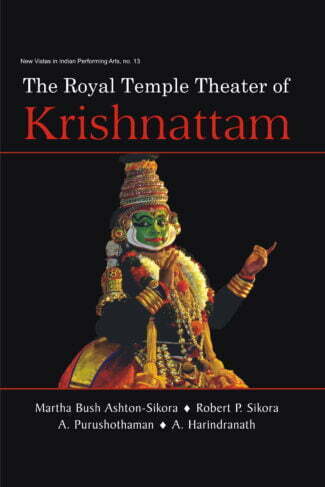
Krishnattam, a unique Sanskrit ritualistic dance-theater of Kerala, is one among India’s treasure trove of rare living artistic masterpieces. This history-travelogue, richly illustrated, takes one along to experience the Krishnattam plays, with their rituals and preparations, as the performers in fantastic, colorful costumes, dance, and mime the story of Lord Krishna’s life to the accompaniment of vocal and instrumental music.
Krishnattam, a unique Sanskrit ritualistic dance-theater of Kerala, is one among Indias treasure trove of rare living artistic masterpieces. In time past, Krishnattam, based on the Sanskrit poem Krishnagiti by the Zamorin King Manaveda, thrived in the royal environment of the Kingdom of Calicut, receiving the adoration of small devoted audiences. But, with Indias independence, the Zamorin lost his kingdom, and as his wealth dissipated, Krishnattam teetered on the edge of extinction. It was the Krishna-Vishnu Temple at Guruvayur that came to Krishnattam’s rescue and has become an integral part of the history of Krishnattam. Here, again, Krishnattam remained in seclusion until 1961, when the troupe performed in Bombay, exposing it to a larger Indian audience and foreign interest.
This history-travelogue takes one along in the dark of night to experience the Krishnattam plays, with their rituals and preparations, as the performers in fantastic, colorful costumes, dance, and mime the story of Lord Krishna’s life to the accompaniment of vocal and instrumental music.
This volume, richly illustrated, makes one meet some people, who have been the soul of Krishnattam. The actor-dancers share the quirks of fate, the severity of training schedule, and the rigor of exercises that transformed them from village children into performers. Currently, Krishnattam thrives at Guruvayur Temple, together with ample outside performances, as a devotional votive offering.
The first author takes one along on her twenty-year journey to discover the history and attractions of this art so rarely performed outside its locale in south India. Co-authors, Robert Sikora, A. Purushothaman and A. Harindranath greatly enhance this edition with their new researches, translations, and photographs.
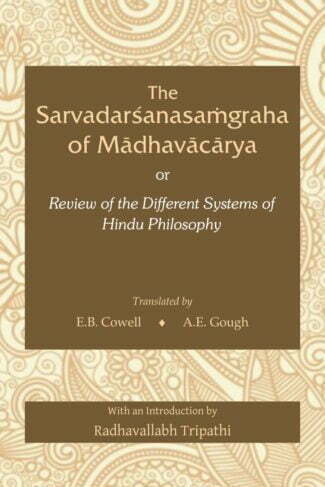
This book is an interesting specimen of Hindu critical ability. It presents the synopsis of sixteen philosophical systems that were current in the fourteenth-century south India in their most important tenets and maintains the principal arguments by which their followers were endeavoured to maintain them.
The Sarvadarshanasamgraha of Madhavacharya is an interesting specimen of Hindu critical ability. The author herein presents the synopsis of sixteen Charvaka, Bauddha, Jaina, Ramanuja, Purnaprajna, Pashupata, Shaiva, Pratyabhijna, Raseshvara, Vaisheshika, Nyaya, Jaiminiya, Paniniya, Samkhya, Patanjala and Advaita philosophical systems current in the fourteenth-century south India in their most important tenets and maintains the principal arguments by which their followers were endeavoured to maintain them. In course of his sketches of these systems, Madhavacharya frequently explains at length obscure details of these different systems.
Sarvadarshanasamgraha presents all these Darshanas from the Vedantic point of view. These had attracted to their study the noblest minds in India throughout the medieval period of its history. There were numerous sects of Bauddha, Jaina, and Hindu philosophical systems and we come across many of them in this book.
This present retypeset edition is quite reader-friendly as we have made a few changes to this edition as value-adds and by incorporating the present-day diacritics.
This English translation of Sarvadarshanasamgraha must evoke keen interest among scholars of philosophy, and researchers and students of philosophy across the globe.

This book is an interesting specimen of Hindu critical ability. It presents the synopsis of sixteen philosophical systems that were current in the fourteenth-century south India in their most important tenets and maintains the principal arguments by which their followers were endeavoured to maintain them.
The Sarvadarshanasamgraha of Madhavacharya is an interesting specimen of Hindu critical ability. The author herein presents the synopsis of sixteen Charvaka, Bauddha, Jaina, Ramanuja, Purnaprajna, Pashupata, Shaiva, Pratyabhijna, Raseshvara, Vaisheshika, Nyaya, Jaiminiya, Paniniya, Samkhya, Patanjala and Advaita philosophical systems current in the fourteenth-century south India in their most important tenets and maintains the principal arguments by which their followers were endeavoured to maintain them. In course of his sketches of these systems, Madhavacharya frequently explains at length obscure details of these different systems.
Sarvadarshanasamgraha presents all these Darshanas from the Vedantic point of view. These had attracted to their study the noblest minds in India throughout the medieval period of its history. There were numerous sects of Bauddha, Jaina, and Hindu philosophical systems and we come across many of them in this book.
This present retypeset edition is quite reader-friendly as we have made a few changes to this edition as value-adds and by incorporating the present-day diacritics.
This English translation of Sarvadarshanasamgraha must evoke keen interest among scholars of philosophy, and researchers and students of philosophy across the globe.
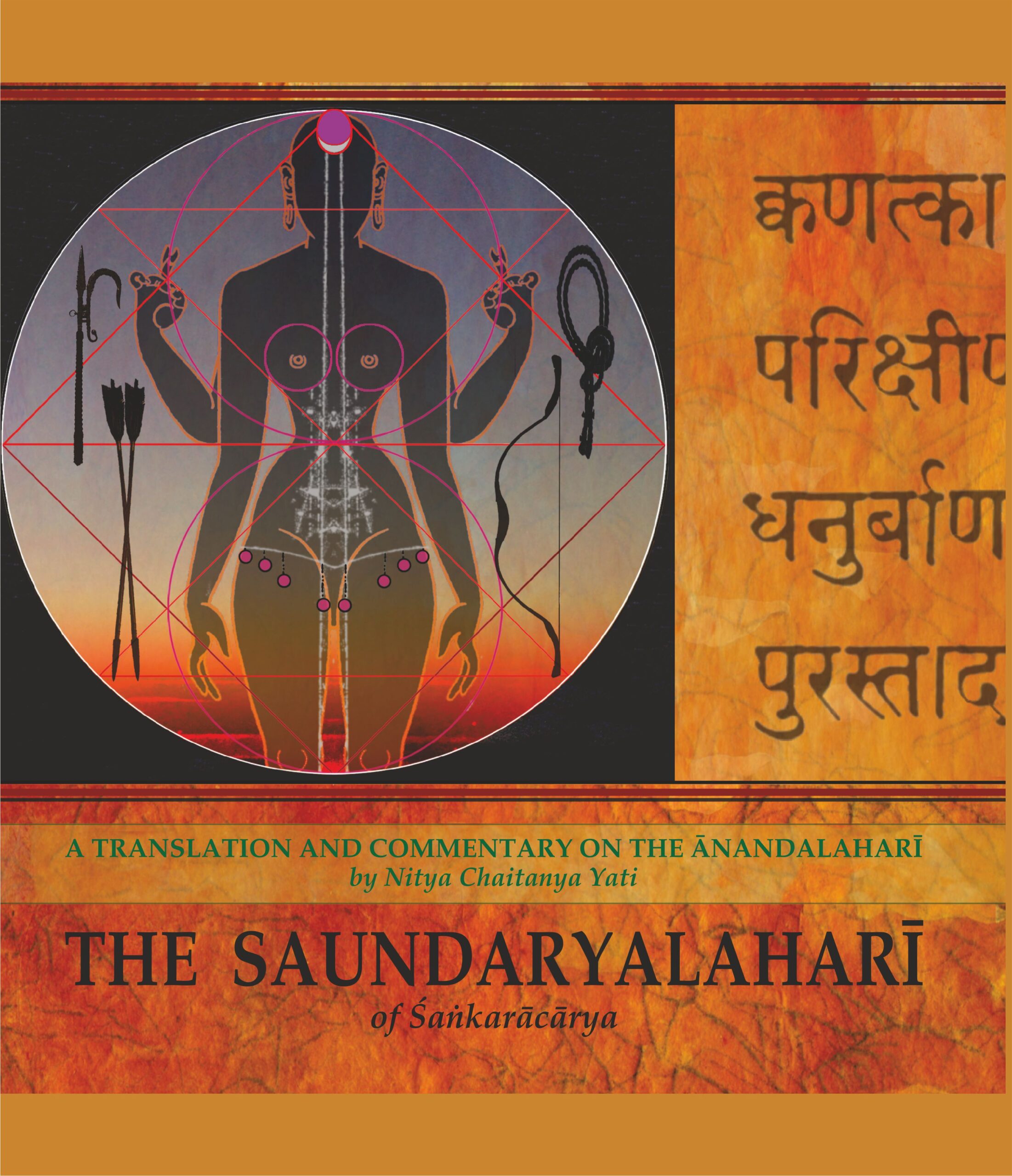
This book comprises the first part of Saundaryalahari, popularly known as Anandalahari. The text is a protolinguistic composition using a pictorial language of images. The absolute joy of Advaita is presented subjectively as ananda and objectively as saundarya. For the contemplation of the Shri Chakra, 53 meditations have also been provided.
This book comprises the first part of Saundarya Lahari (The Upsurging Billow of Beauty), popularly known as Ananda Lahari, covering the first forty-one verses.
This poetic work has fascinated generations of scholars and laypersons with the sublime beauty of the verses in praise of the Devi, but also puzzled people by the authorship of Shankara. The text is a protolinguistic composition using a pictorial language of images. Beauty, elevated to the highest level, provides content to the otherwise abstract notion of the Absolute. The absolute joy of Advaita is presented subjectively as ananda and objectively as saundarya.
This tenth-century hymn to the Devi is a poetic restatement by the philosopher Shankara of his strict Advaita Vedanta monism. In a compelling series of verses, Shankara draws in many strands of Indias heritage and braids them into a vision of luminous, transcendent Beauty.
The present commentary by Guru Nitya Chaitanya Yati grew out of his class of intimate meditations. He has integrated the academic disciplines of aesthetics, linguistics, and psychology with contemplation into a comprehensive study of creative manifestation. The heterodox Tantric Shri Vidya schools are centered on the realistic worship of the Devi or Goddess and the Shri Chakra. Keeping in line with contemplation, the Appendix provides 53 meditations on the Shri Chakra.
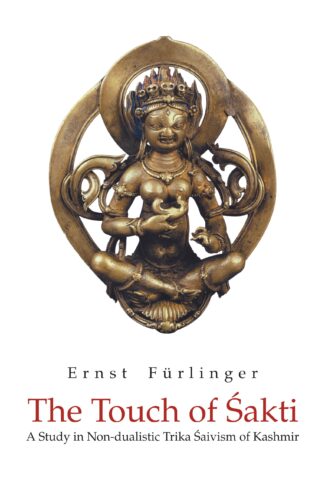
This volume presents an overview of the historical development of the Kashmirian Saiva traditions, especially of the non-dualistic system, Trika, and deals with the bodily experience of the transcendent power, the Sakti, in the context of the Saiva Kundalini-Yoga.
The Kashmirian Shaiva tradition in its non-dualistic form in particular is one of the richest philosophical traditions of India that have survived to the present day. This book by the noted scholar, Dr Furlinger, deals with the bodily experience of the transcendent power, the Shakti, in the context of the Shaiva Kundalini-Yoga. In an insightful introduction, the scholar presents an overview of the historical development of the Kashmirian Shaiva traditions, especially of the non-dualistic system, Trika, made famous by the work of its famous proponent, Abhinavagupta. He studies the theme of shaktisparsha in selected texts of non-dualistic Trika Shaivism of Kashmir, focusing on Utpaladeva’s Shivastotravali of the tenth century and Abhinavagupta’s Tantraloka of the eleventh century. The texts are analysed along with a noted commentary associated with each to shed light on the different contexts and meanings in which the word sparsha occurs in connection with Shakti, the divine power, revered as the Goddess. The study examines sparsa as one of the highest stages in the spiritual ascent in the Tantraloka and its corresponding description in the Shivastotravali. The difference in the notion of sparsa in the two texts is also brought out. It thus reveals the liberating and critical potential of the non-dualistic Shaiva tradition of Kashmir. The book will interest scholars and students of Indology associated with Indian religious-philosophical traditions.
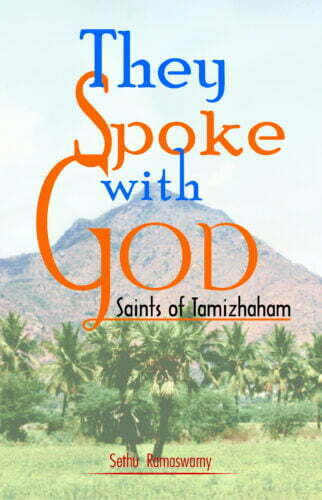
This book, which will interest general readers and scholars, and particularly addressed to young readers, highlights the lives and times of some of the saints of Tamil land who have been the votaries of peace, universal brotherhood and spirituality.
The lives and teachings of saints have a special place in Indian tradition. Saints have been the votaries of peace, universal brotherhood and spirituality and were, and are, among the most loved and revered personages in Indian history and culture. This volume comes as a tribute to the prominent saints of Tamizhaham or Tamil land, who have contributed immensely to Indian culture and society.
It highlights the lives and times of some of the noted exponents of the Shaivite path of devotion. It begins with discussions on some of the famous Nayanar saints like Somasimarar Nayanar and Karaikkal Ammaiyar, and takes up the contributions of medieval bhakti saints like Sridhara Venkateswara Ayyaval and Avudai Akkal. The concluding section deals with the ecstatic saints of the region of the late nineteenth and twentieth centuries. This part contains an account of a woman saint of our own times, Andavan Pichchai Amma, as well. The lives of the saints are told in a simple language that wonderfully unravels their complex messages. The work shows that though the saints had diverse experiences and expressed their spirituality in different ways, the lives of all these saints have an ecstatic and a celebratory quality about them.
The volume will interest general readers as well as scholars. It is particularly addressed to young readers in an effort to introduce them to Indian spiritual and cultural legacy.
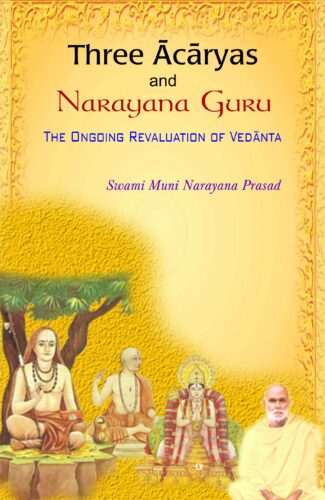
The book speaks about the philosophy of Narayana Guru as guidance to study and compare the philosophies of the acaryas, particularly those of Shankara, Ramanuja and Madhva. It also explores the concepts of avidya and maya, atomicity of the self, consciousness and the self, tat tvam asi, karma and reincarnation and the ultimate liberation.
Shankara, Ramanuja and Madhva are considered the three acaryas of South India who commented on the three basic texts of Vedanta, that is, the Upanishads, the Brahma-Sutras and the Bhagavad-Gita, and therefrom originated the three major schools within the Vedanta fold — Advaita, Vishishtha advaita and Dvaita respectively. This volume is concerned with the philosophy of the famous saint-teacher Narayana Guru and his perspectives on the philosophies of the three acaryas.
The book uses the philosophy of Narayana Guru as the guide to study and compare the philosophies of the acaryas. It begins with the life sketches of the three acaryas and discusses their philosophies, especially the various specific viewpoints they maintained and the points on which they disagreed. It explores the ideas of the acaryas on avidya and maya, atomicity of the self, consciousness and the self, tat tvam asi, karma and reincarnation and the ultimate liberation. It also scrutinises their use of terms like that of atha which literally means now then. It examines the perception of Narayana Guru vis-a-vis the particular philosophical positions in a unified manner. It also contains the full text, transliteration and translation of the original Vedanta-Sutras of Narayana Guru.
The volume will interest students and scholars who are engaged in advanced studies on the philosophy of Vedanta, and persons keen on acquainting themselves with the philosophy of Narayana Guru.

Time is eternal, all-pervasive, money, a good counsellor, and the best-known medicine. The 100 “quotable” quotes on Work in this book are a gold mine of wisdom that renews his spirit and makes him more creative and help him utilize time better for the self and the society. Each quote has a stimulating painting of Lord Ganesha, the Lord of Peace, Prosperity and Wisdom.
Time is eternal and all-pervasive. It is the most potent factor in human life. It waits for none. Time is money. To remind the significance and criticality of Time, the authors have presented 100 exceptional quotes on Time, each quote is enjoined by a stimulating painting of Lord Ganesha, the Lord of Peace, Prosperity and Wisdom. Some of these enlightening and ever-inspiring quotes are from impeccable personalities, who have rendered invaluable services and contributions to the progress of this world. Everything happened, happens and will happen fall under the ambit of time.
Time is the best-known medicine and a good leveller and counsellor. It enables us to overcome the losses of the past and energize to run towards new goals. Though alpha and omega in nature, time is too short for a human being. Thus it reminds everyone to act wisely and harness it fruitfully as the wise, talented and the enlightened do.
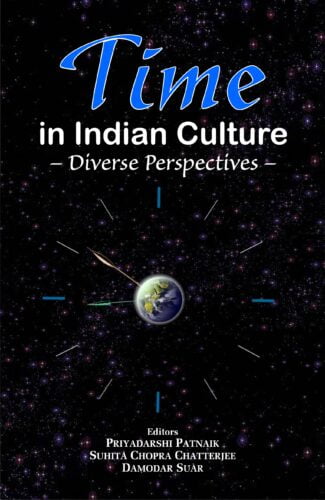
The volume is a comprehensive collection of papers dealing with the philosophical, religious/spiritual, and linguistic aspects of time, and time as understood in Indian art, music and other aspects of culture.
The concept of time has been variously interpreted and debated in the Indian tradition since ancient times. It is referred to by the word kala which has many meanings like time personified, time as death, time as a cycle and so on, and other words like samaya, vela, kshana as well, which refer to various aspects of time.
The volume is a comprehensive collection of papers dealing with the philosophical, religious/spiritual and linguistic aspects of time, and time as understood in Indian art, music and other aspects of culture. Scholars explore themes such as the notion of beginning of time in cosmology, theology and philosophy, time as interpreted by the Indian philosophical systems, use of the notion of time by Bhartrihari, and concepts of time as interpreted by Indian poets. They examine time as experienced in the seasonal, ritual cycles of Indian social, cultural and physical life, use of tala and laya in north Indian music, interpretation of time in the Ragamala painting tradition, perception of time in Indian architecture, and in Indian popular culture.

The book details the significance of the toranas arched portals or festoons in ancient and medieval architecture of South and South-east Asia, with special emphasis on Indian representation. The text is richly illustrated with photographs and line drawings from remote sites, museums and archival collections.
The present work discusses in depth the subject of toraªas (arched portals or festoons) in the ancient and medieval architecture of South- and South-east Asia, with special emphasis on Indian representations. Their antiquity and rationale; their continued presence in association with stupas, caves, temples, mosques, cities, forts, and palaces; their myriad forms and transformations; and their aesthetic and symbolic relationship to the structure in question are analyzed stage-by-stage in this book. The rich corpus of toraªas included here has been critically and comparatively analyzed in relation to traditional practice, as well as in the light of the medieval architectural treatises, historical records, and other literary sources. The approach is micro in the sense of being focused on a specific architectural element but macro in its regional and temporal span. In addition, the exposition reveals the grammar as well as the manifold visual formulations of the toraªa as representative of the basic principles of traditional Indian architectural ornament: integral to the structure, functionally apt, aesthetically significant, and visually evocative, with sound and sophisticated design principles. The text is richly illustrated, bringing together material scattered over several well-known as well as remote sites, museums, and archival collections. Whereas a major part of this book details the journey of the toraªa in ancient and medieval India, the section on early beginnings also includes references from Pakistan and Afghanistan, and the final chapter surveys, with a view to compare, parallel yet distinct expressions in Cambodia, Thailand, Champa, Indonesia, Myanmar, Nepal, and Sri Lanka.
| There are no products |